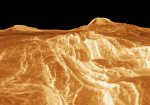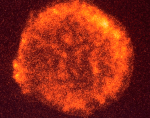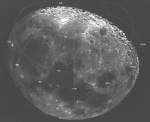
|
Astronomy Picture Of the Day (APOD)
 A Distant Galaxy in the Deep Field
A Distant Galaxy in the Deep Field
28.06.1996
Researchers believe that the faint reddish smudge indicated by the arrow in the image above is a candidate for the most distant known galaxy which may have existed only a few hundred million years after the Big Bang.
 Voyager's Preview of Galileo at Ganymede
Voyager's Preview of Galileo at Ganymede
27.06.1996
NASA's robot spacecraft Galileo began its long voyage to Jupiter in October of 1989. In December of last year it arrived in the Jovian system, beginning its unprecedented, detailed exploration by dropping a probe into the gas giant's atmosphere. By early this morning it will have accomplished another milestone in its ambitious mission.
 Happy Birthday Charles Messier: M1
Happy Birthday Charles Messier: M1
26.06.1996
French astronomer Charles Messier was born on June 26, 1730. Inspired by childhood sightings of comets and a solar eclipse visible from his home town of Badonvillier, he became an astronomer and comet hunter who kept careful records of his observations.
 A Star Forming Region in the LMC
A Star Forming Region in the LMC
25.06.1996
Stars sometimes form in colorful ways. Pictured above is a small region in the nearby LMC galaxy where stars are forming. After a star is born, it may do several things to energize its immediate neighborhood.
 A View from Venus: Rift Valley
A View from Venus: Rift Valley
24.06.1996
Color information from the Soviet Venera landers and radar data from the Magellan spacecraft were used to construct this striking perspective view of the Venusian landscape. (In this computer generated image, the vertical scale has been exagerated.) In the foreground is the edge of a rift valley created by faulting in the crust of Venus.
 Tycho's Supernova Remnant in X-ray
Tycho's Supernova Remnant in X-ray
23.06.1996
How often do stars explode? By looking at external galaxies, astronomers can guess that these events, known as a supernovae, should occur about once every 30 years in a typical spiral galaxy like our MilkyWay.
 North to the Moon's Pole
North to the Moon's Pole
22.06.1996
This image is from the voyage of the intrepid Galileo spacecraft as it passed above the Moon's north pole on its long journey to Jupiter. It was made over 60 years after Admiral Byrd became the first to fly over the Earth's north pole.
21.06.1996
Pictured above is one of the world's premiere radio astronomical observatories: The Very Large Array (VLA). Each antenna dish is as big as a house (25 meters across) and mounted on railroad tracks. The VLA consists of 27 dishes - together capable of spanning the size of a city (35 kilometers).
 Apollo Sunrise
Apollo Sunrise
20.06.1996
In November of 1969, homeward bound aboard the "Yankee Clipper" command module, the Apollo 12 astronauts took this dramatic photograph of the Sun emerging from behind the Earth. From this distant perspective, part...
 Seven Sisters Versus California
Seven Sisters Versus California
18.06.1996
In the lower left corner, dressed in blue, is the Pleiades. Also known as the Seven Sisters and M45, the Pleiades is one of the brightest and most easily visible open clusters on the sky. The Pleiades contains over 3000 stars, is about 400 light years away, and only 13 light years across.
|
January February March April May June July August September October November December |
|||||||||||||||||||||||||||||||||||||||||||||||||